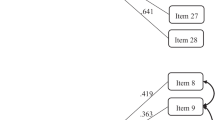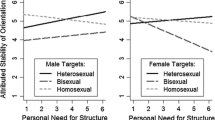Abstract
This study assessed the influence of gender on attitudes about bisexuals. A total of 164 heterosexual female and 89 heterosexual male undergraduates completed the Biphobia Scale (Mulick & Wright, 2002), rewritten to refer to bisexual men and bisexual women and thus re-named the Gender-Specific Binegativity Scale. A mixed-design ANOVA revealed an interaction between rater’s sex and target’s sex: women equally accepted bisexual men and bisexual women, but men were less accepting of bisexual men than bisexual women. A mediation analysis indicated the relationship between rater’s sex and greater acceptance of bisexual women was partially explained by eroticization of female same-sex sexuality. Finally, participants also responded to two open-ended items, which provided additional information about the content of binegativity: participants described male bisexuals negatively, as gender-nonconforming, and labeled them “really gay,” whereas participants described female bisexuals positively, as sexy, and labeled them “really heterosexual.” These findings suggest multiple underlying beliefs about bisexuals that contribute to binegativity, particularly against bisexual men. Results also confirm the importance of considering gender (of both the target and the rater) when assessing sexual prejudice.


Similar content being viewed by others
Change history
02 February 2022
A Correction to this paper has been published: https://doi.org/10.1007/s10508-022-02291-x
Notes
An initial comparison between the White participants and the participants of color on the three attitude scales of interest (GSBS-Men, GSBS-Women, and Eroticization of Lesbian Sex) showed no racial differences (all t values <1.67, all ps > .09). Substantive analyses proceeded without considering race.
Levene’s tests indicated that these data violated the assumption of equality of variances (GSBS-Men p < .001; GSBS-Women p < .05), with the men’s sample showing a larger variance than the women’s sample in both cases. However, after applying an inverse transformation and re-analyzing the data, the results of the ANOVA remained the same (F values dropped slightly, but all p values remained <.001). We concluded that heterogeneity of variance did not unduly affect our results and, therefore, all analyses rely on the untransformed values.
References
Arnett, J. J. (2004). Emerging adulthood: The winding road from the late teens through the twenties. New York: Oxford University Press.
Baron, R. M., & Kenny, D. A. (1986). The moderator-mediator distinction in social psychological research: Conceptual, strategic, and statistical considerations. Journal of Personality and Social Psychology, 51, 1173–1182.
Baumeister, R. F. (2000). Gender differences in erotic plasticity: The female sex drive as socially flexible and responsive. Psychological Bulletin, 126, 347–374.
Bennett, K. (1992). Feminist bisexuality: A both/and option for an either/or world. In E. R. Weise (Ed.), Close to home: Bisexuality and feminism (pp. 205–231). Seattle: Seal Press.
Braun, V., & Clarke, V. (2006). Using thematic analysis in psychology. Qualitative Research in Psychology, 3, 77–101.
Britton, D. M. (1990). Homophobia and homosociality: An analysis of boundary maintenance. Sociological Quarterly, 31, 423–439.
CNN/Opinion Research Corporation. (2010). CNN Opinion research poll. Retrieved from http://i2.cdn.turner.com/cnn/2010/images/08/11/rel11a1a.pdf
Diamond, L. M. (2008a). Female bisexuality from adolescence to adulthood: Results from a 10-year longitudinal study. Developmental Psychology, 44, 5–14.
Diamond, L. M. (2008b). Sexual fluidity: Understanding women’s love and desire. Cambridge, MA: Harvard University Press.
Eagly, A. H., & Chaiken, S. (1993). The psychology of attitudes. Fort Worth, TX: Harcourt Brace Jovanovich.
Eliason, M. J. (1997). The prevalence and nature of biphobia in heterosexual undergraduate students. Archives of Sexual Behavior, 26, 317–326.
Eliason, M. (2001). Bi-negativity: The stigma facing bisexual men. Journal of Bisexuality, 1, 137–154.
Farajajé-Jones, E. (1995). Fluid desire: Race, HIV/AIDS, and bisexual politics. In N. Tucker, L. Highleyman, & R. Kaplan (Eds.), Bisexual politics: Theories, queries, and visions (pp. 119–130). New York: Harrington Park Press.
Gorsuch, R. L. (1983). Factor analysis (2nd ed.). Hillsdale, NJ: Lawrence Erlbaum.
Hamilton, M. C. (1991). Masculine bias in the attribution of personhood: People = male, male = people. Psychology of Women Quarterly, 15, 393–402.
Harman, H. H. (1976). Modern factor analysis (3rd ed., rev.). Chicago: University of Chicago Press.
Herek, G. M. (1986). On heterosexual masculinity: Some psychical consequences of the social construction of gender and sexuality. American Behavioral Scientist, 29, 563–577.
Herek, G. M. (1994). Assessing heterosexuals’ attitudes toward lesbians and gay men: A review of empirical research with the ATLG scale. In B. Greene & G. M. Herek (Eds.), Lesbian and gay psychology: Theory, research, and clinical applications (pp. 206–228). Thousand Oaks, CA: Sage.
Herek, G. M. (1998). Stigma and sexual orientation: Understanding prejudice against lesbians, gay men, and bisexuals. Thousand Oaks, CA: Sage Publications.
Herek, G. M. (2000). Sexual prejudice and gender. Journal of Social Issues, 56, 251–266.
Herek, G. M. (2002). Heterosexuals’ attitudes toward bisexual men and women in the United States. Journal of Sex Research, 39, 264–274.
Herek, G. M. (2003). The psychology of sexual prejudice. In L. D. Garnets & D. C. Kimmel (Eds.), Psychological perspectives on lesbian, gay and bisexual experiences (2nd ed., pp. 157–164). New York: Columbia University Press.
Hudson, W. W., & Ricketts, W. A. (1980). A strategy for the measurement of homophobia. Journal of Homosexuality, 10, 357–371.
Kane, E. W. (2006). “No way my boys are going to be like that!” Parents’ responses to children’s gender non-conformity. Gender and Society, 20, 149–176.
Kimmel, M. S. (1994). Masculinity as homophobia: Fear, shame, and silence in the construction of gender identity. In H. Brod & M. Kaufman (Eds.), Theorizing masculinities (pp. 119–141). London: Sage Publications.
Kite, M. E., & Whitley, B. E. (1996). Sex differences in attitudes toward homosexual person, behaviors, and civil rights: A meta-analysis. Personality and Social Psychology Bulletin, 22, 336–353.
Kite, M. E., & Whitley, B. E. (2003). Do heterosexual women and men differ in their attitudes toward homosexuality? A conceptual and methodological analysis. In L. D. Garnets & D. C. Kimmel (Eds.), Psychological perspectives on lesbian, gay and bisexual experiences (2nd ed., pp. 165–187). New York: Columbia University Press.
Kline, R. B. (1994). An easy guide to factor analysis. London: Routledge.
Lapinski, M., Braz, M., & Maloney, E. (2010). The down low, social stigma, and risky sexual behaviors: Insights from African-American men who have sex with men. Journal of Homosexuality, 57, 610–633.
Laumann, E. O., Gagnon, J. H., Michael, R. T., & Michaels, S. (1994). The social organization of sexuality: Sexual practices in the United States. Chicago: University of Chicago Press.
Le Gall, A., Mullet, E., & Shafighi, R. (2002). Age, religious beliefs, and sexual attitudes. Journal of Sex Research, 39, 207–216.
Logan, C. R. (1996). Homophobia? No, homoprejudice. Journal of Homosexuality, 31, 31–53.
Louderback, L. A., & Whitley, B. E. (1997). Perceived erotic value of homosexuality and sex-role attitudes as mediators of sex differences in heterosexual college students’ attitudes toward lesbians and gay men. Journal of Sex Research, 34, 175–182.
MacCallum, R. C., Widaman, K. F., Zhang, S., & Hong, S. (1999). Sample size in factor analysis. Psychological Methods, 4, 84–99.
Merritt, R. D., & Kok, C. J. (1995). Attribution of gender to a gender-unspecified individual: An evaluation of the people = male hypothesis. Sex Roles, 33, 145–157.
Mohr, J. J., & Rochlen, A. B. (1999). Measuring attitudes regarding bisexuality in lesbian, gay male, and heterosexual populations. Journal of Counseling Psychology, 46, 353–369.
Mosher, W. D., Chandra, A., & Jones, J. (2005). Sexual behavior and selected health measures: Men and women 15–44 years of age, United States, 2002 (Advance data from vital and health statistics, No. 362). Hyattsville, MD: National Center for Health Statistics.
Mulick, P. S., & Wright, L. W. (2002). Examining the existence of biphobia in the heterosexual and homosexual populations. Journal of Bisexuality, 2, 47–64.
Nyberg, K. L., & Alston, J. P. (1977). Homosexual labeling by university youths. Adolescence, 12, 541–546.
Ochs, R. (1996). Biphobia: It goes more than two ways. In B. A. Firestein (Ed.), Bisexuality: The psychology and politics of an invisible minority (pp. 217–239). Thousand Oaks, CA: Sage.
Otis, M. D., & Skinner, W. F. (2004). An exploratory study of differences in views of factors affecting sexual orientation for a sample of lesbians and gay men. Psychological Reports, 94, 1173–1179.
Pratto, F., Sidanius, J., Stallworth, L. M., & Malle, B. F. (1994). Social dominance orientation: A personality variable predicting social and political attitudes. Journal of Personality and Social Psychology, 67, 741–763.
Raja, S., & Stokes, J. P. (1998). Assessing attitudes toward lesbians and gay men: The Modern Homophobia Scale. Journal of Gay, Lesbian, & Bisexual Identity, 3, 113–134.
Reiss, I. L. (1986). A sociological journey into sexuality. Journal of Marriage and the Family, 48, 233–242.
Reiter, L. (1991). Developmental origins of antihomosexual prejudice in heterosexual men and women. Clinical Social Work Journal, 19, 163–175.
Rotter, N. G., & O’Connell, A. N. (1982). The relationships among sex-role orientation, cognitive complexity, and tolerance for ambiguity. Sex Roles, 8, 1209–1220.
Rust, P. C. (2002). Bisexuality: The state of the union. Annual Review of Sex Research, 13, 180–240.
Sandnabba, N. K., & Ahlberg, C. (1999). Parents’ attitudes and expectations about children’s cross-gender behavior. Sex Roles, 40, 249–264.
Savin-Williams, R. C., & Diamond, L. M. (2000). Sexual identity trajectories among sexual-minority youths: Gender comparisons. Archives of Sexual Behavior, 29, 607–627.
Savin-Williams, R. C., & Ream, G. L. (2007). Prevalence and stability of sexual orientation components during adolescence and young adulthood. Archives of Sexual Behavior, 36, 385–394.
Spalding, L. R., & Peplau, L. A. (1997). The unfaithful lover: Heterosexuals’ perception of bisexuals and their relationships. Psychology of Women Quarterly, 21, 611–625.
Stockard, J., & Johnson, M. M. (1979). The social origins of male dominance. Sex Roles, 5, 199–218.
Sumpter, S. F. (1991). Myths/realities of bisexuality. In L. Hutchins & L. Kaahumanu (Eds.), Bi any other name: Bisexual people speak out (pp. 12–13). New York: Alyson Books.
Tabachnick, B. G., & Fidell, L. S. (2001). Using multivariate statistics (4th ed.). New York: Harper and Row.
Tucker, N. (Ed.). (1995). Bisexual politics: Theories, queries, & visions. Binghamton, NY: Haworth Press.
Valdiserri, R. (2004). Mapping the roots of HIV/AIDS complacency: Implications for program and policy development. AIDS Education and Prevention, 16, 426–439.
Weiss, J. T. (2004). GL vs. BT: The archaeology of biphobia and transphobia within the U.S. gay and lesbian community. Journal of Bisexuality, 3, 25–55.
Worthington, R. L., Navarro, R. L., Savoy, H. B., & Hampton, D. (2008). Development, reliability, and validity of the Measure of Sexual Identity Exploration and Commitment (MOSIEC). Developmental Psychology, 44, 22–33.
Wright, L. W., Adams, H. E., & Bernat, J. (1999). Development and validation of the Homophobia Scale. Journal of Psychopathology and Behavioral Assessment, 21, 337–347.
Author information
Authors and Affiliations
Corresponding author
Rights and permissions
About this article
Cite this article
Yost, M.R., Thomas, G.D. Gender and Binegativity: Men’s and Women’s Attitudes Toward Male and Female Bisexuals. Arch Sex Behav 41, 691–702 (2012). https://doi.org/10.1007/s10508-011-9767-8
Received:
Revised:
Accepted:
Published:
Issue Date:
DOI: https://doi.org/10.1007/s10508-011-9767-8




